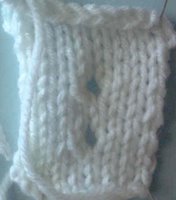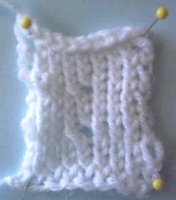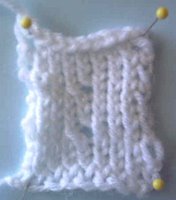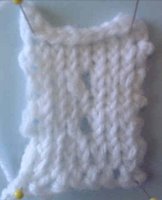Comparative knitting 1-0-whatever or adventures in yfs
Birthday popoki has not been putting her best face forward for photos so she'll have to make her blog debut another time and while both the sleeves and the blooming bikini top projects are coming along smoothly they are also in the some future blog entry queue.
In the picking and throwing clans of knitting I am a confirmed thrower which is to say that I don't knit continental. Within the throwing clan, I am bit promiscuous about how I throw my yarn about.
I am perfectly comfortable mixing up no less than seven different ways to combine knits and purls -- three of the seven form uncrossed/twisted fabric and four formed twisted stitches. All of them have their place and all of them other than the dominant Western uncrossed require some adjustment for translating the instructions written for that dominant throwing style.
My first knitting teacher for some reason or another taught me to knit Eastern Uncrossed and years later when I took knitting back up, several kind souls "corrected" how I formed my knit stitch but they didn't notice my peculiar method of forming the purl stitch. Thus, when I actually knit stocking stitch flat, I was knitting a type of plaited knitting. In my case it is the sort described not by Mary Thomas but by Barbara Abbey.
My next throwing experience had me discovering combined knitting where I could combine the new to me way of throwing my yarn with my quirky way of forming a purl stitch and still get an untwisted fabric.
Eventually I found myself comfortable and familiar with Western uncrossed which is often described as the "normal" way to knit. It is the most mainstream throwing clan, with most of the knitting instructions geared toward those who belong, and to some degree that's what bugs me about it in that, at least in the US, instructions tend to assume that everyone does knit this way and further they often use the same words for different knitting maneuvers and that is particular sticking point for me.
Reasonable minds can differ on these issues and much of the perspective is formed by the individual's experience. So when I get on my hobby horse about saying YO as a generic term that describes at least three different maneuvers it is because of my own and my knitting students' experiences and when, for example, Ste. Joan of Schrouder disagrees with me it is because her experience is different and we can respect that and engage in dialogue.
Different thing entirely IMO when people just tell me that I'm wrong and that a YO is a YO is a YO or that my preference for yf/yrn/yon as more precise terms is somehow meaningless when doing XYZ knitting. I find that especially galling when XYZ knitting is one of the ones in bag of tricks and I know that those terms are totally legit.
I've had this exchange over the years on various lists and mostly learned to just not bother to even try to get dialogue on this issue whether it be to exchange info on whether YO or yf/yrn/yon is more confusing or exactly how a properly (for the style of knitting being produced) formed decorative increase is formed.
This past week, I tried again with mixed results. My initial complaint about imprecise language was based on a poster on a list being stymied by the term yf rather than YO in a pattern stitch instruction. The mixed result was that for a change I got a fairly detailed discussion of how at least one continental knitter worked this knitting instruction K4, yf, sl1, k1, psso, k3 and whether they retained the original 9 stitches or not. I also got Ste. Joan reiterating her mileage (experience) differs from mine and the dreaded "it's just different" with no 'splanation.
So my test engineer side came out and here's the result from 6 out of my 7 different throwing styles. The slip to knit versus the slip to purl is all about how the helpful continental knitter documented her experiments where interestingly enough the slip to knit versus slip to purl resulted in a stitch number difference that I didn't see in any of the 6 throwing forms I tried.
Western Uncrossed:

Close up here:

Western Crossed:

Close up here:

Eastern Uncrossed:

Close up here:

Eastern Crossed:

Close up here:

Combination Knitting

Close up here

Western Crossed:

Close up here:

Eastern Crossed:

Close up here:

Plaitted (Mary Thomas)

Close up here:

In the picking and throwing clans of knitting I am a confirmed thrower which is to say that I don't knit continental. Within the throwing clan, I am bit promiscuous about how I throw my yarn about.
I am perfectly comfortable mixing up no less than seven different ways to combine knits and purls -- three of the seven form uncrossed/twisted fabric and four formed twisted stitches. All of them have their place and all of them other than the dominant Western uncrossed require some adjustment for translating the instructions written for that dominant throwing style.
My first knitting teacher for some reason or another taught me to knit Eastern Uncrossed and years later when I took knitting back up, several kind souls "corrected" how I formed my knit stitch but they didn't notice my peculiar method of forming the purl stitch. Thus, when I actually knit stocking stitch flat, I was knitting a type of plaited knitting. In my case it is the sort described not by Mary Thomas but by Barbara Abbey.
My next throwing experience had me discovering combined knitting where I could combine the new to me way of throwing my yarn with my quirky way of forming a purl stitch and still get an untwisted fabric.
Eventually I found myself comfortable and familiar with Western uncrossed which is often described as the "normal" way to knit. It is the most mainstream throwing clan, with most of the knitting instructions geared toward those who belong, and to some degree that's what bugs me about it in that, at least in the US, instructions tend to assume that everyone does knit this way and further they often use the same words for different knitting maneuvers and that is particular sticking point for me.
Reasonable minds can differ on these issues and much of the perspective is formed by the individual's experience. So when I get on my hobby horse about saying YO as a generic term that describes at least three different maneuvers it is because of my own and my knitting students' experiences and when, for example, Ste. Joan of Schrouder disagrees with me it is because her experience is different and we can respect that and engage in dialogue.
Different thing entirely IMO when people just tell me that I'm wrong and that a YO is a YO is a YO or that my preference for yf/yrn/yon as more precise terms is somehow meaningless when doing XYZ knitting. I find that especially galling when XYZ knitting is one of the ones in bag of tricks and I know that those terms are totally legit.
I've had this exchange over the years on various lists and mostly learned to just not bother to even try to get dialogue on this issue whether it be to exchange info on whether YO or yf/yrn/yon is more confusing or exactly how a properly (for the style of knitting being produced) formed decorative increase is formed.
This past week, I tried again with mixed results. My initial complaint about imprecise language was based on a poster on a list being stymied by the term yf rather than YO in a pattern stitch instruction. The mixed result was that for a change I got a fairly detailed discussion of how at least one continental knitter worked this knitting instruction K4, yf, sl1, k1, psso, k3 and whether they retained the original 9 stitches or not. I also got Ste. Joan reiterating her mileage (experience) differs from mine and the dreaded "it's just different" with no 'splanation.
So my test engineer side came out and here's the result from 6 out of my 7 different throwing styles. The slip to knit versus the slip to purl is all about how the helpful continental knitter documented her experiments where interestingly enough the slip to knit versus slip to purl resulted in a stitch number difference that I didn't see in any of the 6 throwing forms I tried.
Western Uncrossed:

Close up here:

Western Crossed:

Close up here:

Eastern Uncrossed:

Close up here:

Eastern Crossed:

Close up here:

Combination Knitting

Close up here

Western Crossed:

Close up here:

Eastern Crossed:

Close up here:

Plaitted (Mary Thomas)

Close up here:



0 Comments:
Post a Comment
Subscribe to Post Comments [Atom]
<< Home